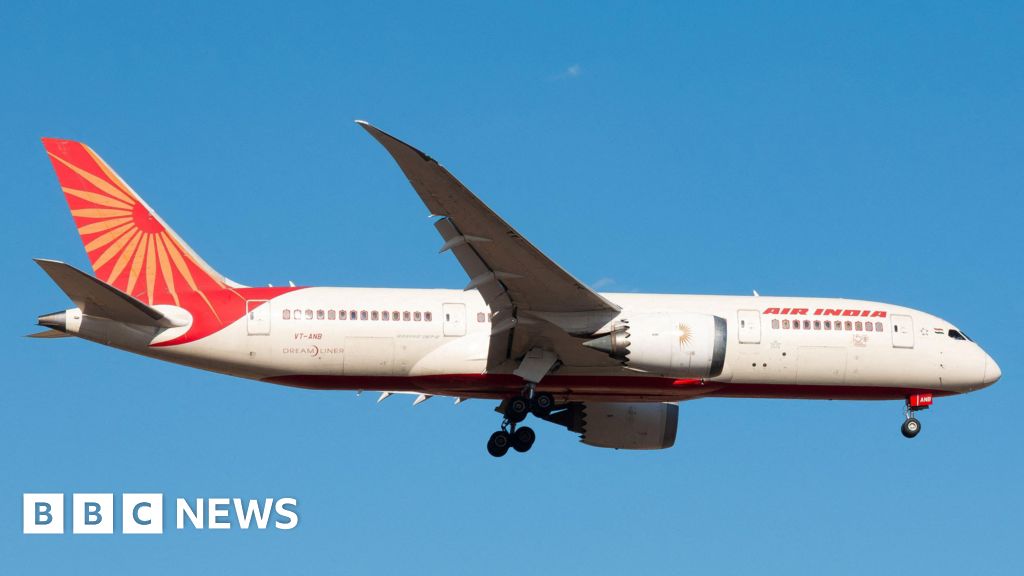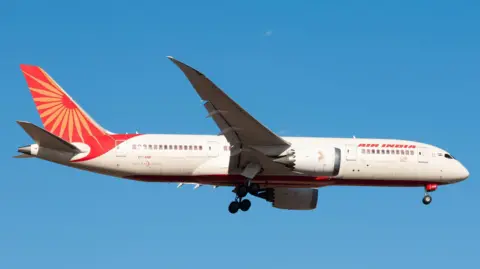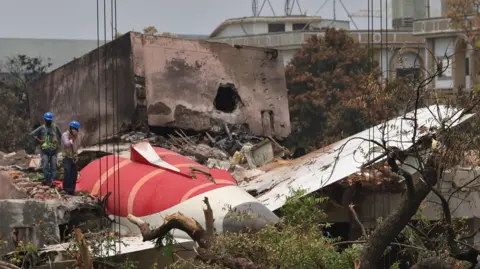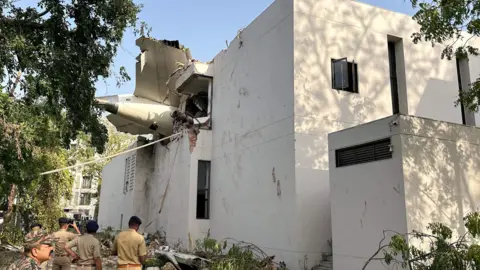Air India: How the Boeing Dreamliner crash investigation is unfolding


 Reuters
Reuters
Less than 40 seconds.
That’s how long Air India Flight 171 was airborne before it plunged into a densely populated neighbourhood in Ahmedabad in one of India’s rarest aviation disasters in recent memory.
Investigators now face the grim task of sifting through the wreckage and decoding the cockpit voice and flight data recorders of the Boeing 787 Dreamliner to piece together what went catastrophically wrong in the seconds after take-off. Under international rules set by the UN aviation body ICAO, a preliminary investigation report should be released within 30 days, with the final report ideally completed within 12 months.
The London Gatwick-bound aircraft, piloted by Captain Sumeet Sabharwal and co-pilot Clive Kundar, lifted off from the western Indian city of Ahmedabad at 13:39 local time [08:09 GMT] on Thursday, with 242 people and nearly 100 tonnes of fuel on board. Within moments, a mayday call crackled from the cockpit. It would be the last transmission. This was followed by a loss of altitude and a crash engulfed in flames.
Captain Kishore Chinta, a former investigator with India’s Aircraft Accident Investigation Bureau (AAIB), calls this “the rarest of the rare” crashes – a controlled flight into terrain just 30 seconds after take-off. “To my knowledge, nothing quite like this has ever happened,” he told the BBC.
Did both engines fail due to bird strikes or fuel contamination? Were the flaps improperly extended, reducing lift on a heavily loaded jet in extreme heat? Was there a maintenance error during engine servicing? Or did an inadvertent crew action cut off fuel to both engines?

 Reuters
Reuters
Investigators will be probing all these possibilities – and more. Air crash investigations rely on triangulation and elimination – matching physical evidence from the wreckage with recorded aircraft performance data to build a coherent picture of what went wrong.
Every scorched cable, damaged turbine blade, airplane maintenance log, and signals and sounds from the flight data and cockpit voice recorders – the so-called “black box” – will be examined. The BBC spoke to accident experts to understand how the investigation will proceed.
Critically, the first clues on the ground may come from the wreckage of the two engines, at least three investigators said.
“You can tell from the damage whether the engines were generating power at impact – turbines fracture differently when spinning at high speed,” says Peter Goelz, a former managing director of US’s National Transportation Safety Board (NTSB). “That’s the first clue to what went wrong.”
Turbines are crucial rotating components that play a key role in extracting energy to generate thrust.
“If the engines weren’t producing power, investigators have a serious case on their hands – and the focus will shift sharply to the cockpit.”
What happened in the cockpit will be revealed by the Boeing 787’s Enhanced Airborne Flight Recorders (EAFRs) – or the “black boxes” – which, investigators say, will help tell the story. (Indian officials say the recorders have been recovered from the crash site.)
These devices capture extensive flight data and cockpit audio – from pilot radio calls to ambient cockpit sounds. Voice recordings come from individual pilot mics, radio transmissions and an area microphone that picks up background noise in the cockpit.
Data recorders track with high precision the position of gear and flap levers, thrust settings, engine performance, fuel flow and even fire handle activation.

 Reuters
Reuters
“If the flight data recorder shows the engines were making full power, then the attention will move to the flaps and slats. If they are found to be extended as needed, then it becomes a very difficult investigation,” says Mr Goelz.
Flaps and slats increase lift at lower speeds, helping an aircraft take off and land safely by allowing it to fly slower without stalling.
“If [the trail leads] to a problem in the flight management control system, that would raise serious concerns – not just for Boeing, but for the entire aviation industry.”
The Boeing 787’s flight management control system is a highly automated suite that manages navigation, performance and guidance. It integrates data from a number of sensors to optimise the aircraft’s flight path and fuel efficiency.
With over 1,100 Boeing 787s flying worldwide since 2011, investigators must determine whether this was a systemic issue that could affect the global fleet – or a one-off failure unique to this flight, experts say. “If it points to a system problem, then the regulatory bodies have to make some tough decisions very quickly,” says Mr Goelz.
So far, there is no indication of fault on anyone’s part. India’s civil aviation ministry said on Tuesday that a recent inspection of Air India’s Boeing 787 fleet – 24 of 33 aircraft have been checked so far – “did not reveal any major safety concern,” adding that the planes and maintenance systems complied with existing standards.
Boeing President and CEO Kelly Ortberg said on 12 June: “Boeing will defer to India’s Aircraft Accident Investigation Bureau (AAIB) for information on Air India Flight 171, in line with UN ICAO protocol.”
Decoding of the data at the AAIB lab in Delhi will be led by Indian investigators, with experts from Boeing, engine-maker GE, Air India and Indian regulators. Investigators from the NTSB and UK will also be participating.
“In my experience, teams can usually determine what happened fairly quickly,” Mr Goelz says. “But understanding why it happened can take much longer.”
The wreckage may yield other clues. “Every part – wire, nut, bolt – will be meticulously collected,” says Mr Chinta.
Typically, wreckage is moved to a nearby hangar or secure facility, laid out to identify the nose, tail and wingtips, and then pieced together. In this case, depending on what the flight data and voice recorders reveal, a full reconstruction may not be necessary, investigators say.
The importance of wreckage varies by accident, say investigators. For Malaysia Airlines flight MH17, shot down over eastern Ukraine in July 2014, it was crucial – reconstruction of the nose revealed clear shrapnel damage from a Russian-made missile.

 Bloomberg via Getty Images
Bloomberg via Getty Images
In the wreckage, investigators will also examine fuel filters, lines, valves and residual fuel to check for contamination – something that’s easy to detect or rule out, a crash investigator who preferred to remain unnamed, said. Also, he believed that the refuelling equipment used before departure “has likely been quarantined and already inspected”.
That’s not all. Investigators will gather maintenance and fault history records from the airline and Boeing’s ACARS (Aircraft Communications Addressing and Reporting system) which transmits data via radio or satellite to both Boeing and Air India, says Mr Chinta.
They will review all flights operated by the aircraft and the crew over recent months, along with the technical log of pilot-reported faults and corrective actions taken before release of aircraft to service.
Investigators will also examine pilot licenses, training records, simulator performance and instructor remarks – including how pilots handled scenarios like engine failures in advanced flight simulators. “I reckon Air India would have already provided these records to the investigation team,” says Mr Chinta.
Investigators will review the service history of all components of the aircraft that were removed and replaced, examining reported defects for any recurring issues – or signs of problems that could have affected this flight.
“These investigations are extraordinarily complex. They take time, but there will be early indicators of what likely went wrong,” says Mr Goelz.
A big reason is how far technology has come. “One of the first accidents I investigated in 1994 had a flight data recorder tracking just four parameters,” he says.
“Today’s recorders capture hundreds – if not thousands – every second. That alone has transformed the way we investigate crashes.”
Follow BBC News India on Instagram, YouTube, Twitter and Facebook.












